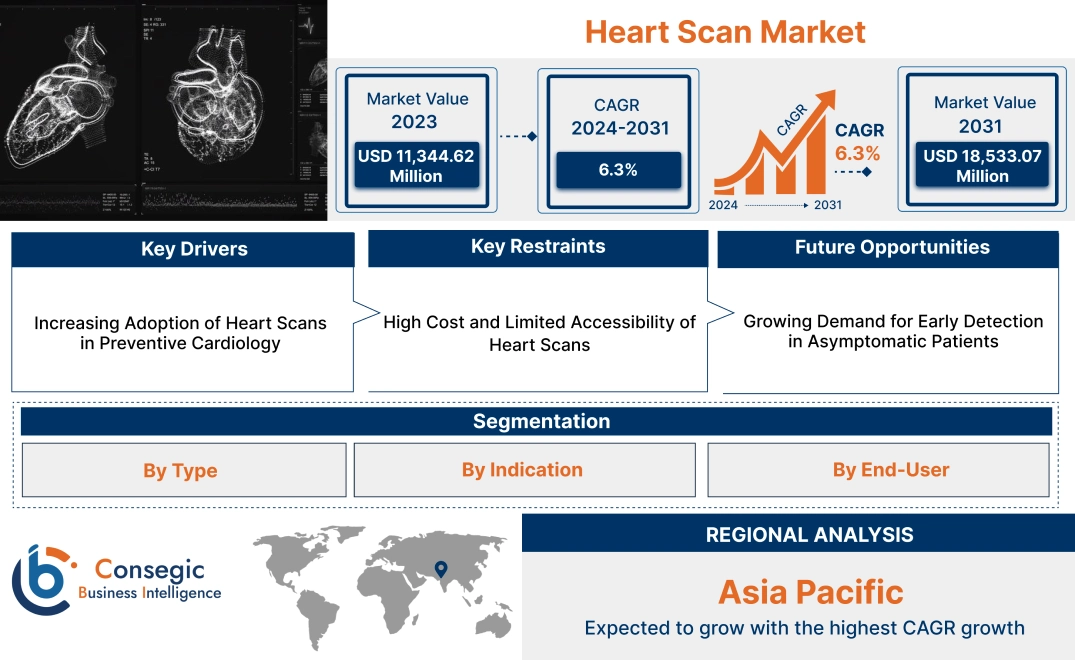- Summary
- Table Of Content
- Methodology
Heart Scan Market Size:
Heart Scan Market size is estimated to reach over USD 18,533.07 Million by 2031 from a value of USD 11,344.62 Million in 2023 and is projected to grow by USD 11,860.35 Million in 2024, growing at a CAGR of 6.3% from 2024 to 2031.
Heart Scan Market Scope & Overview:
A heart scan, also known as a coronary calcium scan, is a specialized imaging test that utilizes computed tomography (CT) technology to capture detailed images of the heart. It measures the presence and extent of calcified plaque within the coronary arteries. Calcified plaque buildup indicates a higher risk of coronary artery disease (CAD), which lead to heart attacks. Heart scans provide early detection of cardiovascular issues, helping medical professionals assess heart health and tailor treatment plans effectively. The procedure is non-invasive, quick, and offers a reliable assessment of a patient's risk of developing cardiac conditions. Heart scans find applications in hospitals, diagnostic centers, and specialty clinics, aiding in preventive cardiology and improved patient care.
Heart Scan Market Dynamics - (DRO) :
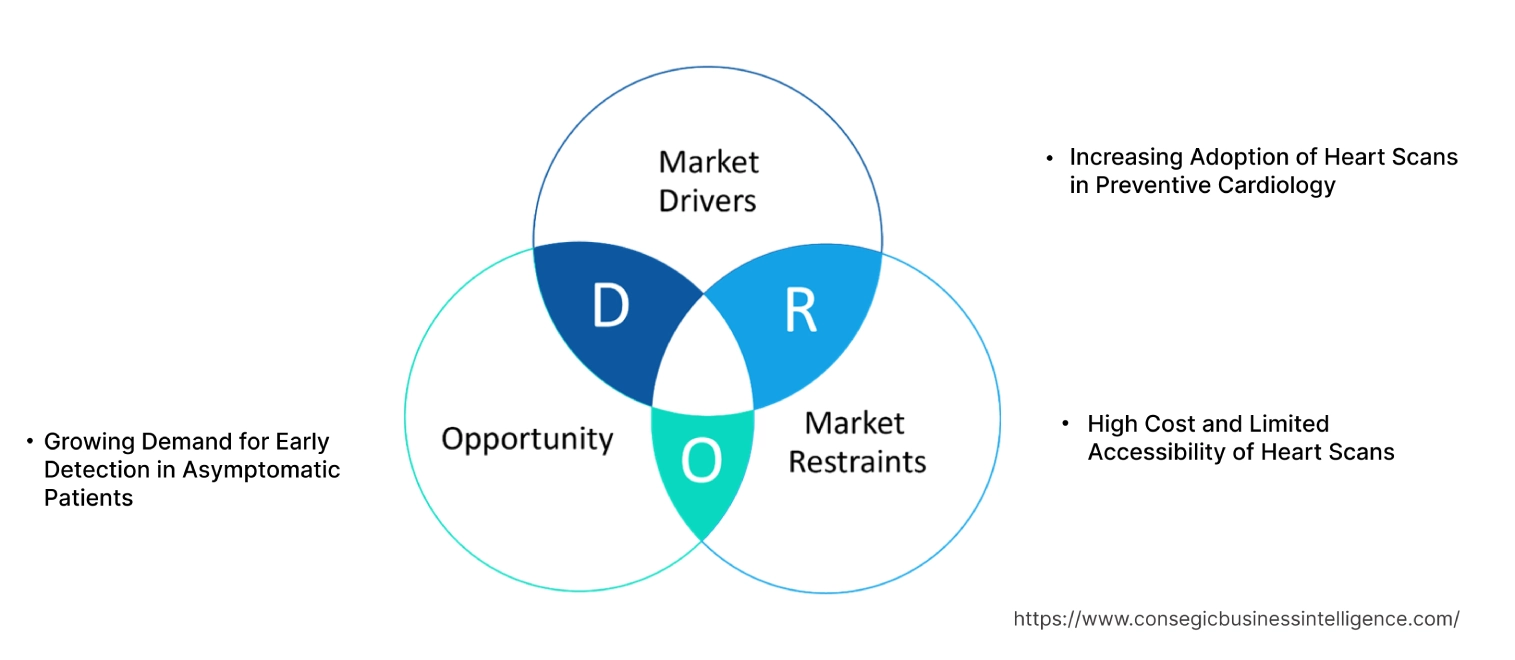
Key Drivers:
Increasing Adoption of Heart Scans in Preventive Cardiology
The growing focus on preventive cardiology has led to an increased adoption of heart scans for early detection of coronary artery disease (CAD). Heart scans, which utilize CT technology to identify calcified plaque in the coronary arteries, play a crucial role in risk assessment. This early detection capability is vital for patients with a family history of heart disease or those exhibiting symptoms like chest pain, even with normal stress test results. The detailed imaging from heart scans enables healthcare providers to develop personalized treatment plans, reducing the likelihood of heart attacks and improving patient outcomes. For instance, a study published by the American Heart Association highlighted that heart scans helped identify 60% more patients at risk of cardiac events than traditional assessments alone. This increasing use of heart scans in hospitals and specialty clinics for preventive screening underscores their significance in mitigating cardiovascular risks.
Key Restraints :
High Cost and Limited Accessibility of Heart Scans
The high cost associated with heart scans, along with limited accessibility in certain regions, poses a significant restraint to market growth. Heart scans, especially those involving advanced computed tomography (CT) technology, require expensive equipment and skilled professionals for accurate interpretation. These factors contribute to elevated procedure costs, making heart scans less accessible for individuals in low-income settings or regions with limited healthcare infrastructure. Additionally, many insurance providers do not cover the cost of heart scans for preventive purposes, further limiting patient access. This analysis shows financial barrier reduces the adoption of heart scans, particularly in rural areas and developing countries, hindering the heart scan market expansion share.
Future Opportunities :
Growing Demand for Early Detection in Asymptomatic Patients
The increasing emphasis on early detection of heart diseases in asymptomatic patients offers a significant opportunity for the heart scan market. Many individuals with coronary artery disease (CAD) may not exhibit symptoms until the disease is advanced, making early screening crucial for timely intervention. Heart scans provide a reliable, non-invasive method to identify calcified plaque buildup in the coronary arteries, even before symptoms appear. This growing heart scan market demand for early detection tools is driven by the rise in awareness campaigns and proactive health screenings, particularly in developed nations. As healthcare providers focus more on preventive measures, the analysis shows adoption of heart scans is expected to increase opportunity, and driving market growth and trend.
Heart Scan Market Segmental Analysis :
By Type:
Based on type, the market is segmented into echocardiogram (ECG), electron beam computed tomography (EBCT), nuclear heart scan, angiocardiography, cardiac catheterization, coronary arteriography, and others.
The echocardiogram (ECG) segment accounted for the largest revenue share of 29.87% in 2023.
- Echocardiograms, also known as ECGs, are widely used due to their non-invasive nature and ability to provide detailed images of the heart's structure and function using ultrasound waves.
- ECGs are essential in diagnosing a wide range of cardiovascular conditions, including heart valve abnormalities, congenital heart defects, and issues related to the heart muscle.
- The increasing prevalence of cardiovascular diseases, combined with the widespread availability of ECG technology in both hospital and outpatient settings, has driven the dominance of this segment.
- The ongoing advancements in portable and handheld echocardiography devices have further increased the adoption of ECGs in various clinical settings.
- In conclusion, the segmental analysis shows Echocardiograms dominate the market trend due to their non-invasive nature, widespread availability, and critical role in diagnosing various cardiovascular conditions, supported by advancements in portable technology opportunities.
The nuclear heart scan segment is anticipated to register the fastest CAGR during the forecast period.
- Nuclear heart scans involve the use of radioactive tracers to visualize blood flow to the heart muscle, providing valuable insights into the heart's function and the presence of ischemia or infarction.
- This type of scan is particularly useful in evaluating patients with suspected coronary artery disease (CAD) and in determining the extent of myocardial damage.
- The increasing focus on early detection and accurate diagnosis of CAD, along with technological advancements in nuclear imaging, is driving the rapid heart scan market growth of this segment.
- The shift towards non-invasive and precise diagnostic methods in cardiology further supports the expansion and increases new opportunities for nuclear heart scans.
- Conclusion, according the segmental analysis trends shows nuclear heart scans are expected to grow rapidly, driven by their ability to provide detailed functional insights into the heart and the increasing share and rise demand for non-invasive diagnostic tools for coronary artery disease.
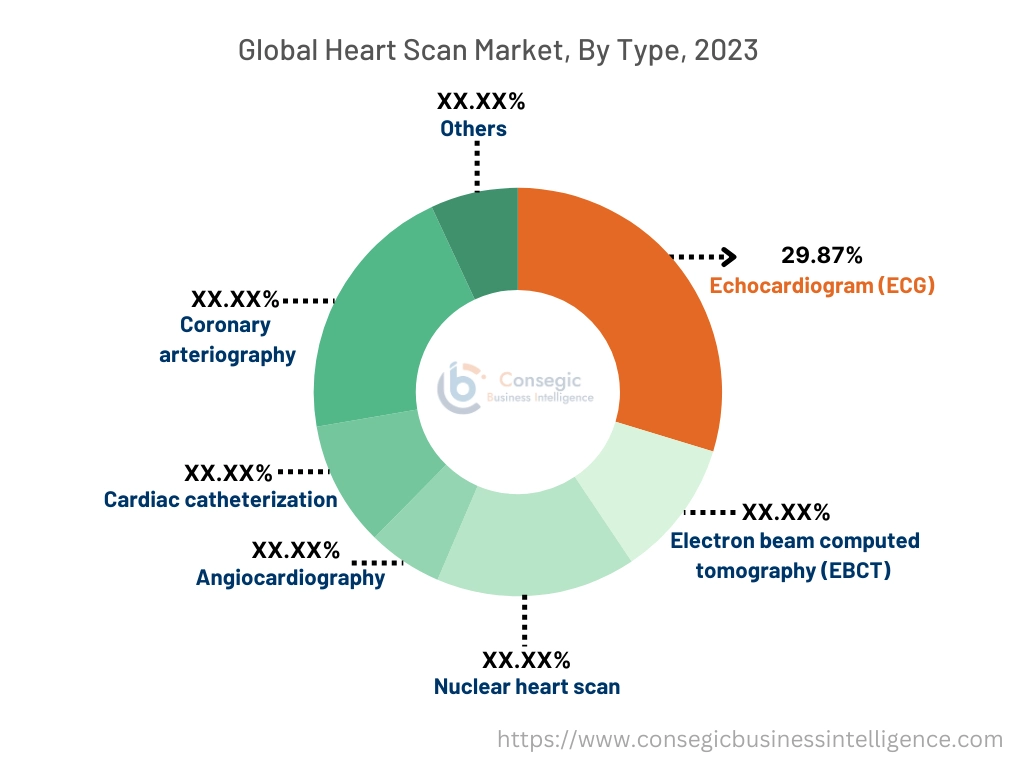
By Indication:
Based on indication, the market is segmented into coronary artery blockage, congenital heart disease, blood clots, tumors, and others.
The coronary artery blockage segment accounted for the largest revenue share in 2023.
- Coronary artery blockage is a major health concern globally, often leading to life-threatening conditions such as myocardial infarction (heart attack).
- Heart scans play a critical role in diagnosing blockages in the coronary arteries, allowing for timely intervention and management.
- Techniques like coronary arteriography and electron beam computed tomography (EBCT) are particularly effective in detecting plaque buildup and narrowing in the arteries.
- The increasing prevalence of coronary artery disease, driven by factors such as poor lifestyle choices and aging populations, is significantly boosting the heart scan market demand for focusing on detecting blockages.
- Conclusion, segmental analysis trends shows Coronary artery blockage leads the market, driven by the high prevalence of coronary artery disease and the critical role of heart scans in early detection and management of arterial blockages.
The congenital heart disease segment is anticipated to register the fastest CAGR during the forecast period.
- Congenital heart diseases (CHD) involve structural abnormalities present at birth, requiring detailed imaging for accurate diagnosis and ongoing monitoring.
- Advances in heart scan technologies, including echocardiography and magnetic resonance imaging (MRI), have greatly improved the ability to detect and assess congenital defects early in life.
- The increasing awareness of CHD, along with advancements in pediatric cardiology and fetal imaging, is driving the rapid growth of this segment.
- The growing use of non-invasive imaging techniques for early diagnosis in newborns and infants further supports the heart scan market expansion.
- Conclusion, segmental analysis portrays congenital heart disease is expected to grow rapidly due to advancements in diagnostic imaging technologies and the increasing focus on early detection and management of structural heart defects.
By End-User:
Based on end-user, the market is segmented into medical laboratories, research institutes, hospitals & clinics, specialty cardiac centers, and others.
The hospitals & clinics segment accounted for the largest revenue share in 2023.
- Hospitals and clinics are the primary settings for heart scan procedures, given their access to advanced diagnostic imaging equipment and specialized healthcare professionals.
- These facilities handle a high volume of cardiovascular cases, making them the largest consumers of heart scan technologies.
- The increasing prevalence of cardiovascular diseases, along with the growing focus on early diagnosis and intervention, has driven demand for advanced imaging techniques in hospitals and clinics.
- Additionally, the availability of multidisciplinary teams and comprehensive care in hospital settings supports the dominant position of this segment.
- Conclusion, Hospitals and clinics segment analysis lead the market trend as the primary settings for heart scan procedures, driven by their access to advanced imaging technologies and the increasing demand for comprehensive cardiovascular care.
The specialty cardiac centers segment is anticipated to register the fastest CAGR during the forecast period.
- Specialty cardiac centers focus exclusively on diagnosing and treating heart conditions, offering advanced diagnostic imaging services as part of their comprehensive care.
- These centers are equipped with the latest heart scan technologies, including nuclear imaging and advanced echocardiography, which allow for precise and detailed assessment of cardiovascular health.
- The rising number of specialty centers dedicated to cardiology, along with increasing patient preference for specialized care, is expected to drive the growth of this trend in this segment.
- The focus on personalized and high-quality cardiac care further enhances the adoption of advanced heart scan technologies in these facilities.
- Conclusion, specialty cardiac centers are expected to grow rapidly, driven by their focus on advanced, specialized care and the increasing demand for high-quality diagnostic imaging services in cardiology boosting the market share.
Regional Analysis:
The regional segment includes North America, Europe, Asia Pacific, the Middle East and Africa, and Latin America.
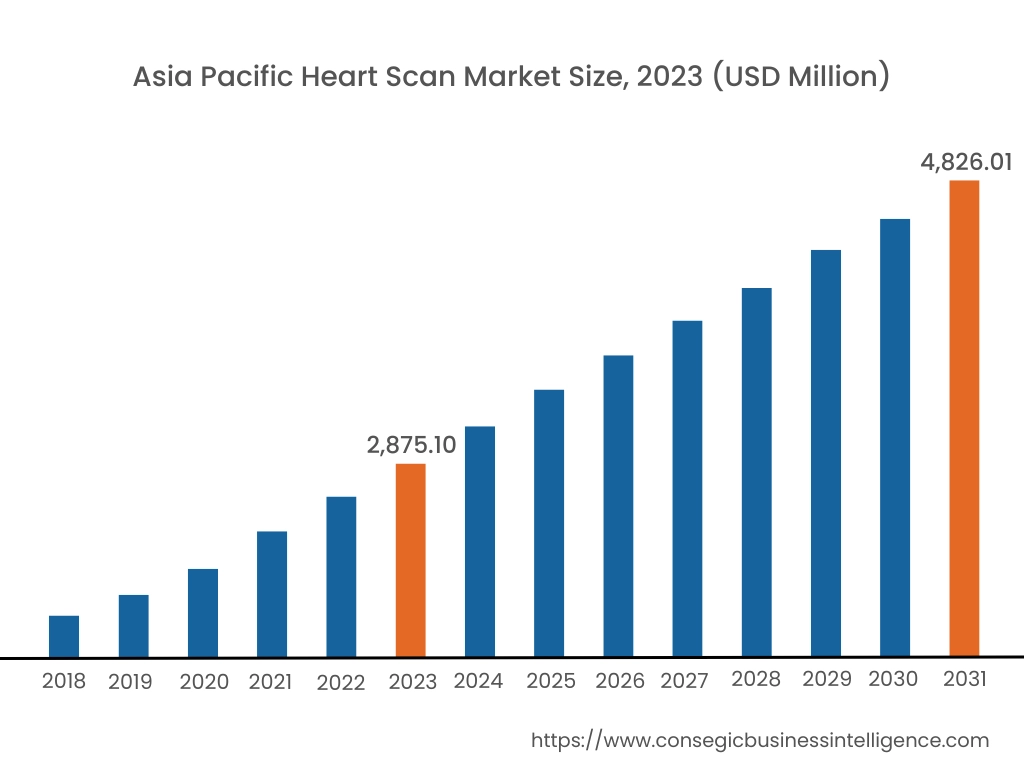
Asia Pacific region was valued at USD 2,875.10 Million in 2023. Moreover, it is projected to grow by USD 3,012.69 Million in 2024 and reach over USD 4,826.01 Million by 2031. Out of this, China accounted for the maximum revenue share of 34.5%. The Asia-Pacific market is witnessing rapid heart scan market growth driven by a rising prevalence of heart diseases, increasing healthcare investments, and expanding medical tourism. Countries like China and India are seeing increased adoption of heart scan technologies due to improved healthcare access, growing patient awareness, and rising disposable income.
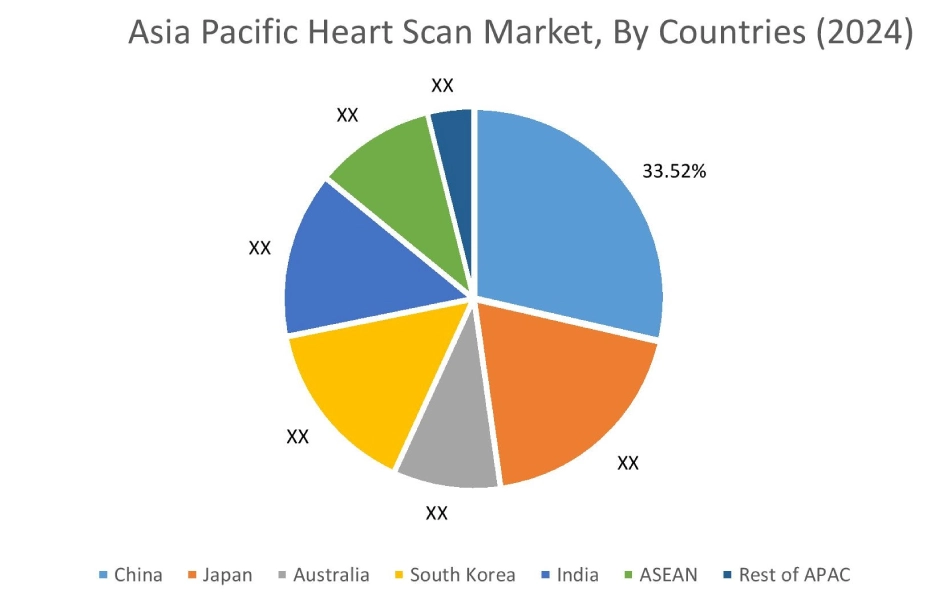
North America is estimated to reach over USD 6,558.85 Million by 2031 from a value of USD 3,977.42 Million in 2023 and is projected to grow by USD 4,161.50 Million in 2024. The market is driven by the rising incidence of cardiovascular diseases, advanced healthcare infrastructure, and increasing awareness of preventive diagnostics. High adoption of technologically advanced imaging systems, including cardiac CT and MRI, enhances the heart scan market demand. The U.S. leads due to substantial healthcare expenditure and a strong presence of key market players.
The market in Europe is expanding due to the growing elderly population and increasing cases of coronary artery disease. Government initiatives for early diagnosis and the integration of AI in cardiac imaging systems support market growth. Germany and the UK are the major contributors due to strong healthcare systems and the rising trend of investment in advanced diagnostics.
The market in the Middle East and Africa is expanding slowly due to limited access to advanced healthcare services. However, increasing government investments in healthcare infrastructure and rising awareness of cardiovascular health are boosting demand. The UAE and Saudi Arabia are the primary heart scan markets growth due to higher healthcare spending.
In Latin America, the heart scan market is driven by increasing cases of hypertension and diabetes, which are major risk factors for heart disease. Brazil and Mexico dominate the market due to the rising number of healthcare industry facilities, increased adoption trends of diagnostic imaging technologies, and government initiatives promoting cardiovascular health.
Top Key Players & Market Share Insights:
The heart scan market is highly competitive with major players providing products in the national and international markets. Key players are adopting several strategies in research and development (R&D), product innovation, and end-use launches to hold a strong position in the global heart scan market. Key players in the heart scan industry include:
- Boston Scientific Corporation (United States)
- Coloplast (Denmark)
- Dispocard GmbH (Germany)
- St. Jude Medical (United States)
- Abbott Laboratories (United States)
- Johnson & Johnson (United States)
- Teleflex Incorporated (United States)
- Smiths Medical (United States)
- Edwards Lifesciences Corporation (United States)
- Medtronic Inc. (United States)
- Maquet Medical India Private Limited (India)
- Terumo Medical Corporation (Japan)
Recent Industry Developments :
Product Launch:
- In 2023, Siemens' Somatom Pro.Pulse, introduced at RSNA, provides high-resolution cardiac imaging at an affordable price, catering to patients with high heart rates. Similarly, Canon's Aquilion One Insight Edition delivers comprehensive heart scans in a single rotation, reducing imaging time and improving efficiency.
Heart Scan Market Report Insights :
| Report Attributes | Report Details |
| Study Timeline | 2018-2031 |
| Market Size in 2031 | USD 18,533.07 Million |
| CAGR (2024-2031) | 6.3% |
| By Type |
|
| By Indication |
|
| By End-user |
|
| By Region |
|
| Key Players |
|
| North America | U.S. Canada Mexico |
| Europe | U.K. Germany France Spain Italy Russia Benelux Rest of Europe |
| APAC | China South Korea Japan India Australia ASEAN Rest of Asia-Pacific |
| Middle East and Africa | GCC Turkey South Africa Rest of MEA |
| LATAM | Brazil Argentina Chile Rest of LATAM |
| Report Coverage |
|
Key Questions Answered in the Report
What is a heart scan, and how does it work? +
A heart scan, or coronary calcium scan, is a specialized imaging test that uses computed tomography (CT) to detect and measure calcium deposits in the coronary arteries. The scan helps identify the risk of heart disease by visualizing plaque buildup that could lead to heart attacks.
Why is the heart scan market growing rapidly? +
The market growth is driven by the increasing prevalence of cardiovascular diseases, rising adoption of preventive healthcare measures, advancements in diagnostic imaging technology, and growing awareness about the importance of early heart disease detection.
What are the common types of heart scans available in the market? +
The most common types include coronary artery calcium (CAC) scans, echocardiograms, nuclear stress tests, and coronary CT angiography. These scans help assess heart function, detect blockages, and evaluate the presence of coronary artery disease.
Who are the primary end-users of heart scan services? +
End-users typically include hospitals, diagnostic imaging centers, cardiology clinics, and ambulatory surgical centers (ASCs). The increasing patient pool and growing demand for accurate diagnosis contribute to the expansion of these services.
How accurate are heart scans in predicting heart disease? +
Heart scans are highly effective in detecting coronary artery calcification, a key indicator of heart disease. However, they are typically used in conjunction with other diagnostic tests and a patient’s medical history for a comprehensive risk assessment.
